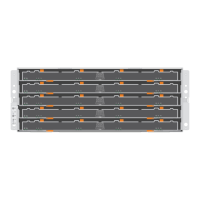Chapter 1: Cabling Concepts and Best Practices 3
Controller Tray
A controller tray contains controllers. A controller tray does not contain drives.
Controller trays configure, access, and manage the storage space of attached drive
trays.
Controller-Drive
Tray
A controller-drive tray contains both controllers and drives. The controllers
configure, access, and manage the storage space of the drives in the controller-drive
tray. A controller-drive tray might configure, access, and manage the storage space of
other attached drive trays, depending upon the model.
Host Channels and
Drive Channels
In this document, the term channel refers to a path for the transfer of data information
and control information between the host and the controller, or between the drive
trays and the controller trays or controller-drive trays. A data path from a host to a
controller is a host channel. A host channel might be Fibre Channel, InfiniBand,
iSCSI, or Serial Attached SCSI (SAS). A path from a drive trays to a controller trays
or a controller-drive trays is a drive channel. Each drive channel is defined by a single
Fibre Channel-Arbitrated Loop or by a series of SAS devices connected through
expanders. Controllers have between two and eight available host channels, and
between one and eight available drive channels, depending upon the model. The
maximum number of hosts per host channel and the maximum number of drives per
drive channel depends upon the model. For model-specific information, see the topics
under "Product Compatibility" on page 31.
NOTE When you mix different types of drive trays, you must consider the total
number of drives that are available in the final configuration of the storage array. Your
configuration must meet both the limit on the total number of drives and the limits on
the number of drive trays of a given model.
Host Ports and Drive
Ports
The ports are the physical connectors on the controller tray or the controller-drive tray
that, along with the cables, enable the transfer of data. If the port communicates with
the host server, it is a host port. If the port communicates with a drive tray, it is a drive
port. The figures in the topics under "Component Locations" show the connectors on
the rear of each of the various trays. These figures will help you differentiate between
host ports and drive ports.

